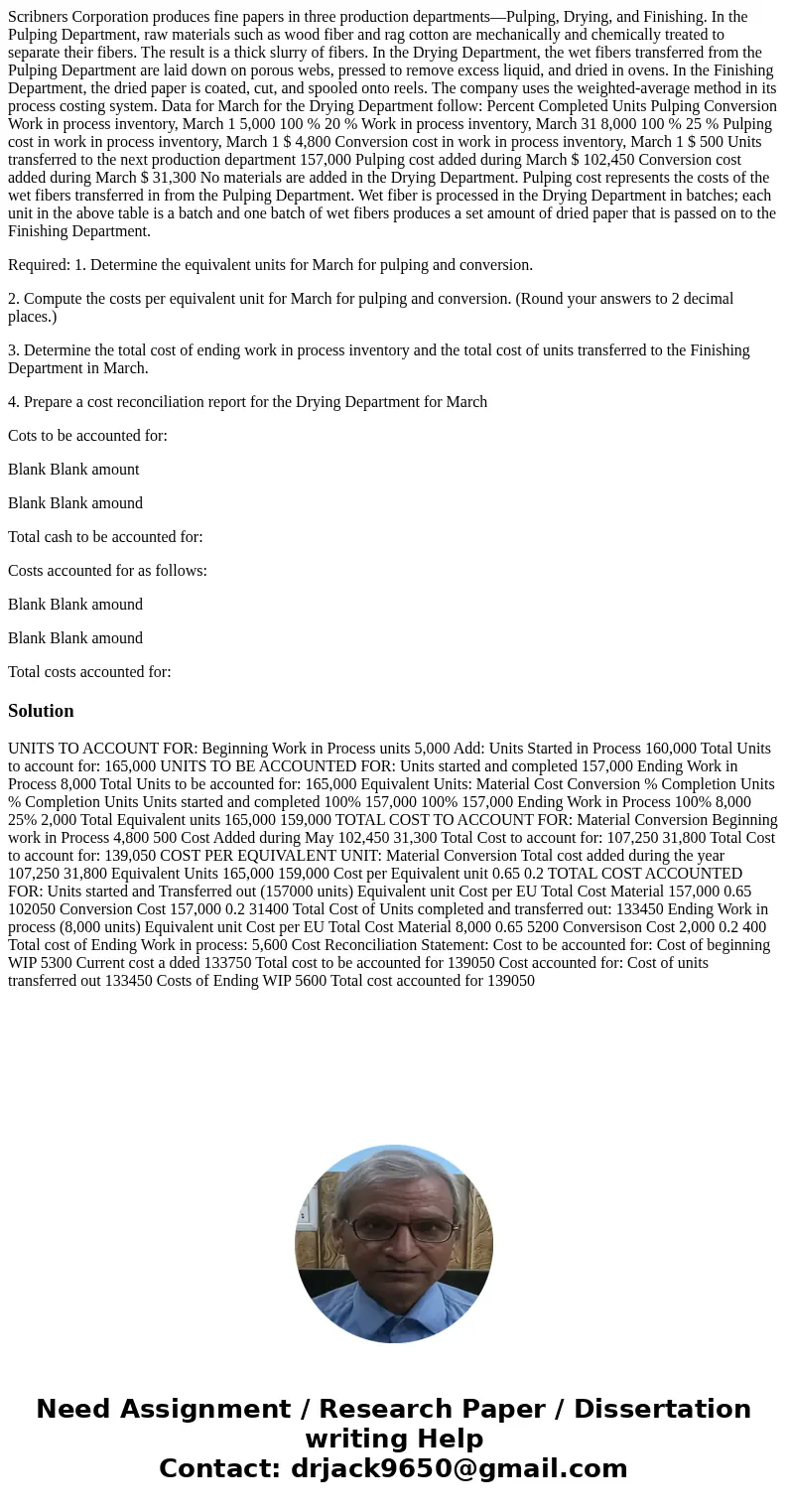Scribners Corporation produces fine papers in three producti
Scribners Corporation produces fine papers in three production departments—Pulping, Drying, and Finishing. In the Pulping Department, raw materials such as wood fiber and rag cotton are mechanically and chemically treated to separate their fibers. The result is a thick slurry of fibers. In the Drying Department, the wet fibers transferred from the Pulping Department are laid down on porous webs, pressed to remove excess liquid, and dried in ovens. In the Finishing Department, the dried paper is coated, cut, and spooled onto reels. The company uses the weighted-average method in its process costing system. Data for March for the Drying Department follow: Percent Completed Units Pulping Conversion Work in process inventory, March 1 5,000 100 % 20 % Work in process inventory, March 31 8,000 100 % 25 % Pulping cost in work in process inventory, March 1 $ 4,800 Conversion cost in work in process inventory, March 1 $ 500 Units transferred to the next production department 157,000 Pulping cost added during March $ 102,450 Conversion cost added during March $ 31,300 No materials are added in the Drying Department. Pulping cost represents the costs of the wet fibers transferred in from the Pulping Department. Wet fiber is processed in the Drying Department in batches; each unit in the above table is a batch and one batch of wet fibers produces a set amount of dried paper that is passed on to the Finishing Department.
Required: 1. Determine the equivalent units for March for pulping and conversion.
2. Compute the costs per equivalent unit for March for pulping and conversion. (Round your answers to 2 decimal places.)
3. Determine the total cost of ending work in process inventory and the total cost of units transferred to the Finishing Department in March.
4. Prepare a cost reconciliation report for the Drying Department for March
Cots to be accounted for:
Blank Blank amount
Blank Blank amound
Total cash to be accounted for:
Costs accounted for as follows:
Blank Blank amound
Blank Blank amound
Total costs accounted for:
Solution
UNITS TO ACCOUNT FOR: Beginning Work in Process units 5,000 Add: Units Started in Process 160,000 Total Units to account for: 165,000 UNITS TO BE ACCOUNTED FOR: Units started and completed 157,000 Ending Work in Process 8,000 Total Units to be accounted for: 165,000 Equivalent Units: Material Cost Conversion % Completion Units % Completion Units Units started and completed 100% 157,000 100% 157,000 Ending Work in Process 100% 8,000 25% 2,000 Total Equivalent units 165,000 159,000 TOTAL COST TO ACCOUNT FOR: Material Conversion Beginning work in Process 4,800 500 Cost Added during May 102,450 31,300 Total Cost to account for: 107,250 31,800 Total Cost to account for: 139,050 COST PER EQUIVALENT UNIT: Material Conversion Total cost added during the year 107,250 31,800 Equivalent Units 165,000 159,000 Cost per Equivalent unit 0.65 0.2 TOTAL COST ACCOUNTED FOR: Units started and Transferred out (157000 units) Equivalent unit Cost per EU Total Cost Material 157,000 0.65 102050 Conversion Cost 157,000 0.2 31400 Total Cost of Units completed and transferred out: 133450 Ending Work in process (8,000 units) Equivalent unit Cost per EU Total Cost Material 8,000 0.65 5200 Conversison Cost 2,000 0.2 400 Total cost of Ending Work in process: 5,600 Cost Reconciliation Statement: Cost to be accounted for: Cost of beginning WIP 5300 Current cost a dded 133750 Total cost to be accounted for 139050 Cost accounted for: Cost of units transferred out 133450 Costs of Ending WIP 5600 Total cost accounted for 139050
 Homework Sourse
Homework Sourse